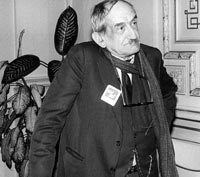Name Andre-Georges Haudricourt | ||
André-Georges Haudricourt (January 17th, 1911 - August 20th, 1996) was a French botanist, anthropologist and linguist.
Contents
Biography
André-Georges Haudricourt grew up on his parents’ farm, in a remote area of Picardy. From his early childhood he was curious about technology, plants, and languages. After he obtained his baccalauréat in 1928, his father advised him to enter the National Institute of Agriculture (Institut national agronomique), in the hope that he would obtain a prestigious position in the administration. But at graduation (1931), Haudricourt got the worst mark of the entire year group: unlike his peers, he was not interested in promoting modern tools and technology, but in understanding traditional technology, societies, and languages. He attended lectures in geography, phonetics, ethnology, and also in genetics in Paris. Marcel Mauss obtained funding for him to go to Leningrad for one year to pursue studies in genetics with Nikolai Vavilov, whose lectures he had attended with great interest at the National Institute of Agriculture.

In 1940, Haudricourt was awarded a position in the newly created Centre national de la recherche scientifique, in its Botany department, but he was disappointed by the research being done there, which relied on static classifications instead of an evolutionary approach espousing the new developments of genetics. In August 1940, the linguist Marcel Cohen entrusted to Haudricourt his library of books about linguistics before he joined the Résistance, as he was afraid the German occupation army may confiscate his library. This allowed Haudricourt to make extensive readings in linguistics during the Second World War. During the same period he also studied Asian languages at the École nationale des langues orientales vivantes.
Haudricourt decided to switch from the Botany department of CNRS to its Linguistics department in 1945. In 1947, he presented a PhD dissertation (supervised by André Martinet) about Romance languages. This nonconformist thesis was not accepted by the two reviewers, Albert Dauzat and Mario Roques; and Haudricourt was not allowed to teach at the École pratique des hautes études. Instead, Haudricourt volunteered to work at the École française d'Extrême-Orient in Hanoi from 1948 to 1949. There, he was able to clarify issues in the historical phonology of Asian languages and to develop general models of language change.
Within the Centre national de la recherche scientifique (CNRS), Haudricourt co-founded in 1976 a research centre whose goal is to investigate little-documented languages within their cultural environment, combining ethnological and linguistic work: the LACITO research centre (Langues et Civilisations à Tradition Orale).
Main contributions
Haudricourt is considered as the founder of the panchronic program in historical phonology.
The study of the history of Chinese, Vietnamese and other East Asian languages draws on seminal insights of A.-G. Haudricourt, who clarified how a toneless language can become tonal. L'origine des tons en vietnamien explains tonogenesis in Vietnamese and numerous other East and Southeast Asian languages, paving the way for the reconstruction of non-tonal ancestors to the languages of Mainland Southeast Asia, such as Proto-Sino-Tibetan and Proto-Tai. A more comprehensive account of the development and evolution of tonal systems was published by Haudricourt in 1961.
Haudricourt’s main legacies to the field of Chinese historical phonology, apart from his systematic account of tonogenesis, are his reconstruction of final *-s and of labiovelars.
Haudricourt clarified several rhyming patterns found in the Book of Odes. Words with final stops /-p -t -k/ rhyme with words in departing tone (去聲 qùshēng) according to their MC pronunciation: for instance, words in the zhà 乍 and zuó 昨 series (MC: *dzraeH and *dzak, respectively) rhyme, as do words in the bì 敝 and piē 瞥 series (MC : *bjiejH and *phiet). This led Karlgren to reconstruct a voiced series of finals: /*-d/, /*-g/, and also /*-b/ in some cases. Haudricourt’s theory that the departing tone comes from *-s explains this phenomenon: the words with departing tone rhyming with words in final stop should be reconstructed with final clusters *-ks, *-ts or *-ps. Moreover, from the point of view of historical morphology, Haudricourt’s theory of tonogenesis leads to the reconstruction of several *-s suffixes (in particular a nominalizing suffix) which can be shown to be cognate with those found in conservative languages of the Sino-Tibetan family, such as Tibetan.
A second major finding consists in the hypothesis that there were labiovelars in Old Chinese:
“…it seems that scholars have overlooked the fact that some rhymes in the Analytic Dictionary only appear with velar initials (/k/, /kʰ/, /g/, /x/, and /ŋ/), for instance -iʷei [MC *-wej] 齊, -ʷâng [*-wang] 唐, -iʷäng [*-jweng] 清, -ʷâk [*-wak] 鐸, -iʷet [*-wet] 屑etc.” (translation by Guillaume Jacques; the Middle Chinese reconstructions added in square brackets are from Baxter 1992).
This idea was used later to revise the reconstruction of the Old Chinese vowel system, and is the basis for the six-vowel system that is common to recent systems.
